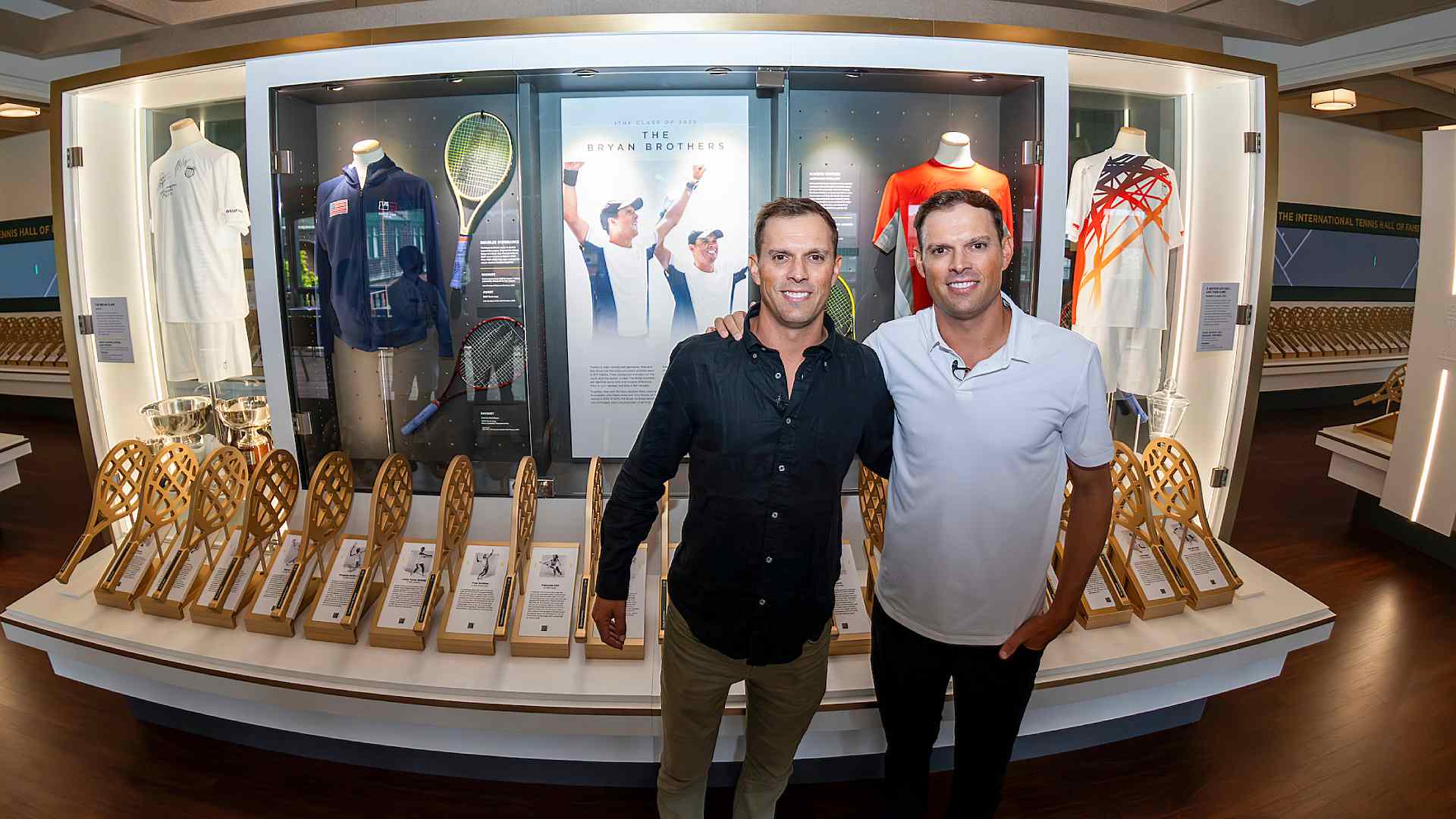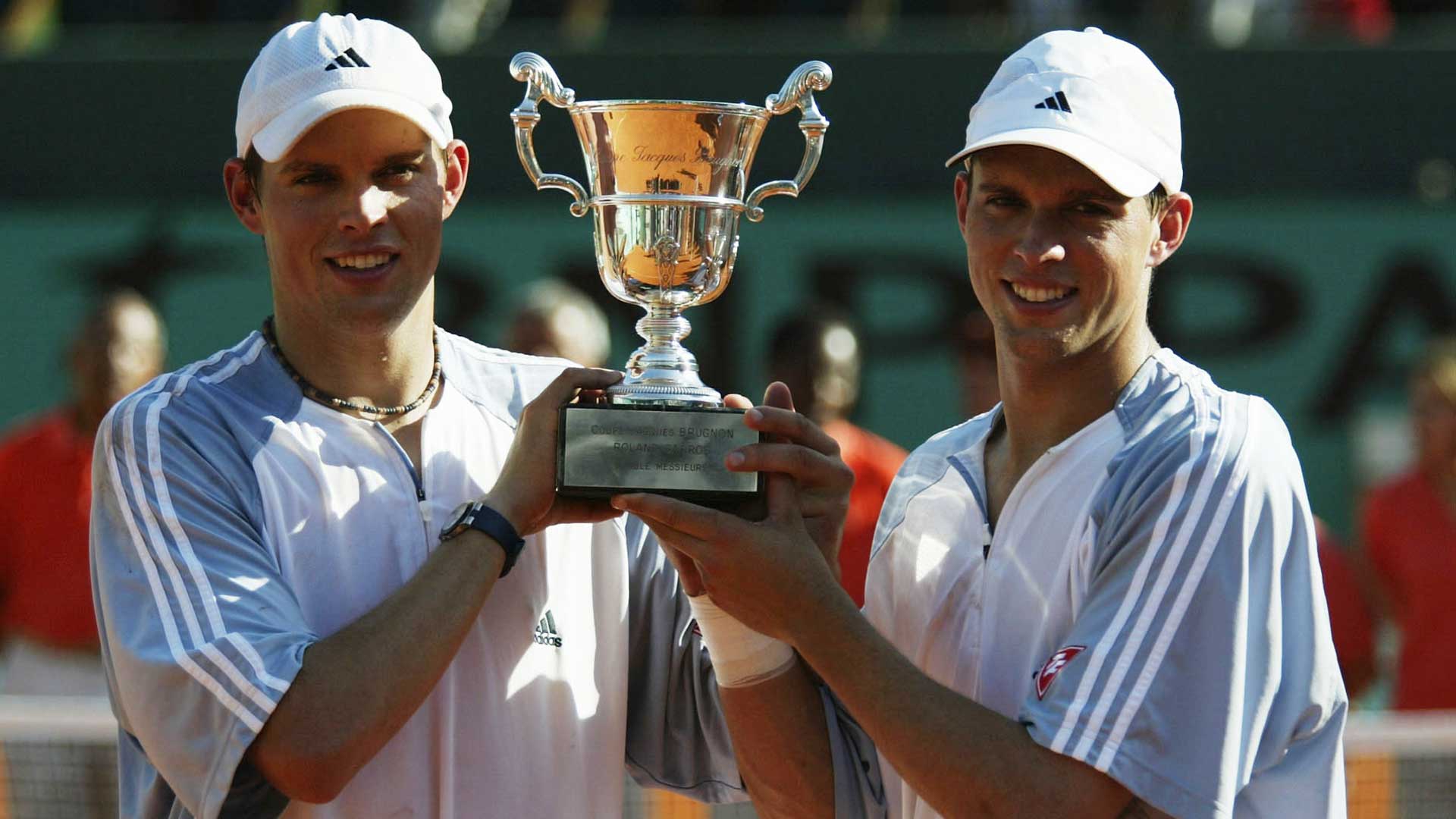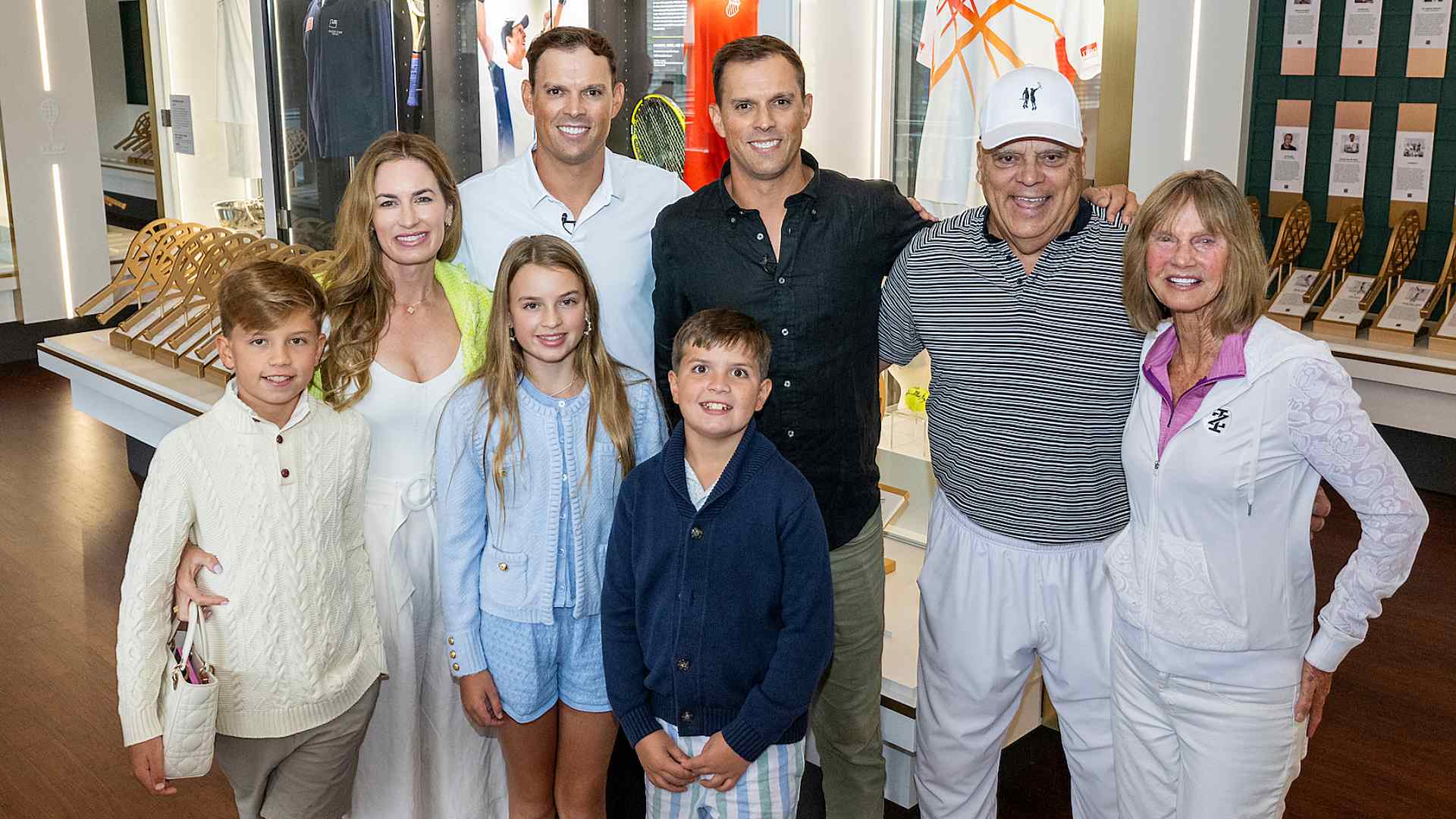

They were more than just champions. They were a force. Bob and Mike Bryan didn’t just win in doubles, they revolutionised it.
Across two decades, the American twins reshaped the landscape of men’s doubles with a record-breaking 119 titles, including 16 majors, 39 ATP Masters 1000 crowns, four Nitto ATP Finals trophies and an Olympic gold medal.
Their stats are historic and their legacy undeniable, but as they sit down in July on a weathered wooden bench overlooking the courts at Wimbledon, a place where they etched part of their legend, you don’t find two men eager to list off accolades. You find humbleness and gratitude for the journey they’ve been on.
“We truly loved the sport and played with a lot of energy,” Bob told ATPTour.com. “We fed off the fans and loved representing our country. Some of our highlights were playing Davis Cup and the Olympics. It was a hell of a ride. Doing it all with your best friend and twin was pretty cool too.”
“I think we’d like to be remembered as two players who really loved what they did,” Mike added. “We were passionate about doubles, about giving back to the game and hopefully inspiring some kids to pick up a racquet. We always tried to make time to sign autographs, take pictures with fans, and just be a positive force in doubles.”
This week, the tennis world pays tribute to the Bryans, who will be inducted into the International Tennis Hall of Fame in Newport, Rhode Island. A final crowning achievement for the most accomplished duo the game has ever seen.
“It’s amazing. We thought maybe we had a chance, but when we got on the ballot, we were stoked,” Mike said. “We were super happy. Then Kim Clijsters, one of the presidents of the Hall of Fame, called us. We were ecstatic. It’s been a fun year to reflect and think back on our career. The Hall of Fame feels like the ultimate honour in tennis. It’s cool to look back at how many people were instrumental in our journey and gave us the chance to play so long.
“We did an event for the Hall of Fame recently, and just being around those legends, our idols like Stan Smith, Billie Jean King, Chris Evert, Martina Navratilova, was surreal. We were like, ‘What are we doing here?’ It felt incredible to be among them.”
The Bryans' journey started in matching Cardinal red in 1997 when they helped Stanford University lift the NCAA Men’s Team Championship. The following year, they returned to grab the NCAA doubles title, while Bob also won the singles.
Their college days provided not just a launchpad for their careers, but a foundation that was crucial to their long-lasting success.
“Our Stanford coach had a motto: ‘Proud, but never satisfied’. We won the NCAAs in ’97, and the next day he was already talking about next year,” Bob said. “That mindset stuck with us. We rarely celebrated wins for long. We were already looking ahead.”
It was that mentality that carried them quickly through the levels. After making their ATP Tour debut in Atlanta, their first title came in Memphis in 2001 and in 2002 they were Masters 1000 champions for the first time in Toronto. By 2003, they were major champions, winning Roland Garros and knocking down the door to global stardom.
“It changed everything winning the French,” Bob remembered. “Marketing, sponsorships. We suddenly got more deals and bought our first house. It took the pressure off. Financially, things improved. We had a lot of sponsor events, appearances. We started to feel the pull, probably a fraction of what Federer and Nadal were dealing with. But we were feeling that pull. Doing the commercials were a lot of fun.”

Bob Bryan and Mike Bryan celebrate winning Roland Garros in 2003. Photo: Getty Images
While Mike agreed, he also noted the deep psychological impact of their Paris final win.
“We had been a good team for a while, but you never know if you have what it takes,” Mike said. “Winning our first French Open was huge. We got there early, stayed at a budget hotel and we were superstitious. We ate at the same Chinese restaurant every day for 21 days. We were so nervous and driven.
“When we won, we both dropped to our knees in unison. That moment gave us confidence. Patrick McEnroe then picked us for Davis Cup, which had been our top goal. He told us we had to win a Slam before he'd take us. That unlocked our careers again.”
That much desired Davis Cup call-up came four months later away in Bratislava. Competing in a World Group playoff on clay against Slovakia, the pressure was on. Led by recently crowned US Open champion Andy Roddick, the United States earned a 3-2 victory, with the Bryans delivering victory in the pivotal doubles rubber to swing the tie in the United States’ favour.
“Our first Davis Cup tie in Bratislava with Roddick, who had just won the US Open, was unforgettable,” Bob said. “It was a relegation match and we had to win to stay in the World Group. Patrick McEnroe showed a lot of confidence in us, using two roster spots on a doubles team.
“We won in straight sets, but it was emotional. Mike was cramping by the end. We wanted it so badly, the tension was high. That match could’ve changed everything if we’d lost. We might never have played again.”
From that point forward, the Bryans became cornerstones of Team USA. They helped clinch the Davis Cup in 2007 and compiled a 25-5 record in the competition, the best ever by an American doubles team. The brothers, who also won Olympic gold in London 2012, relished the opportunity to compete for their country.
“We always loved team play. Davis Cup felt huge with an entire day devoted to doubles,” Mike said. “Playing with legends like Agassi, Roddick, and Blake was a dream. We grew up watching the U.S. team with our faces painted and drums in the stands. We treated every tie like a Slam final. We’d arrive 10 days early, start getting nervous a few days before, stop eating. It mattered that much.”

The Bryan Brothers celebrate winning the Davis Cup in 2007. Getty Images
On Tour, they set the gold standard in doubles for more than 15 years, becoming the heartbeat of the format during the 2000s. Their dominance didn’t just elevate their own careers, but also helped crucially revitalise and promote doubles on a global scale. They first climbed to No. 1 in the PIF ATP Doubles Teams Rankings in September 2003 and never looked back, holding the top spot for an astonishing 438 weeks and finishing as the year-end No. 1 team a record 10 times. Mike even holds the all-time record for most weeks at No. 1 by a doubles player with 506.
Their relentless drive on court, paired with their charisma and fan-friendly energy, made them crowd favourites around the world. That connection led to a remarkable run as the ATP Fans’ Favourite Doubles Team for 13 straight years and 14 times overall.
“It was about consistency, professionalism and having a daily routine,” Bob said on what it took to stay at No. 1. “You wake up with a goal to improve. We pushed each other, but we were also self-motivated. To stay at the top, you have to keep evolving, take feedback, and never settle.
“We were No. 1 in 2003, but we didn’t stay the same. If we had, we wouldn't have finished No. 1 in 2014. Everyone is watching your game, trying to beat you. Players swing freely against the top team and you feel that pressure. So, we just focused on producing our best tennis.”
Mike was a master at the net, quick to intercept and almost never missing a volley. His return game was just as lethal, rifling returns low at the server’s feet or past the net player, setting up Bob for his signature move: the poach. Widely regarded as one of the greatest poachers in doubles history, Bob’s explosive movement and instincts made their return game a devastating one-two punch. Their seamless teamwork, complementary strengths and constant attacking mindset made them nearly impossible to break down and a nightmare for opponents.
Mike believes their success on court was also built on their impressive connection, communication and team dynamic.
“It’s like a marriage,” Mike said. “High pressure, different backgrounds and you’re playing for your livelihood. But we had open communication and were loyal. We also had a coach who acted like a marriage counsellor. Dave Macpherson pushed us to play aggressively, take risks, and treat every final like we had to earn it. That shift made a big difference.
“But the chemistry is the most important thing in doubles. Some great players don’t succeed in doubles because they lack that connection.”

The Bryans celebrate their ninth of a record 10 year-end No. 1 finishes in London in 2013. Getty Images
Even as Bob underwent hip surgery in 2018, the brothers came back to win three more titles together. They finished with a remarkable 1,109-359 team record, according to the Infosys ATP Win/Loss Index, and they ended their career in 2020 after one final triumph in Delray Beach.
Today, the brothers remain deeply involved in the sport, with Bob serving as the U.S. Davis Cup captain. They continue to lead the Bryan Brothers Foundation, which supports at-risk youth and helps charities, while they also embrace life as proud family men. Bob is married to Michelle and is a devoted father to Michaela, Bobby Jr. and Richie. Mike is married to Nadia and has two sons, Jake and Tommy.
“We’ve stayed in tennis since we finished and I think we will always be around the sport,” Bob said. “I’m the Davis Cup captain, and we both coached at the Olympics. We love inspiring the next generation. Our kids are starting to pick up racquets, and while the game is getting tougher, we think it’s an amazing way to grow up.
“We’d love for our kids to play college tennis. Those were some of our best years. Playing on a team, getting an education, and growing as people. There’s no rush. The college path is a great one for development.”

Photo: Ben Solomon/Hall of Fame
After finishing the interview, the twins stood up from the bench and made their way toward the rail overlooking Court No. 18 at Wimbledon. A young teenager approached shyly, asking for an autograph.
‘You’re the brothers that used to win all the time,’ the teenager said.
Mike smiled, glancing at his brother. ‘Something like that.’
A quiet moment, but a lasting one and a perfect snapshot of a legacy that continues to echo across generations. This week, that legacy finds a permanent home in the International Tennis Hall of Fame, where fans can reflect on the pair’s iconic chest bump and title-winning tennis for ever more.